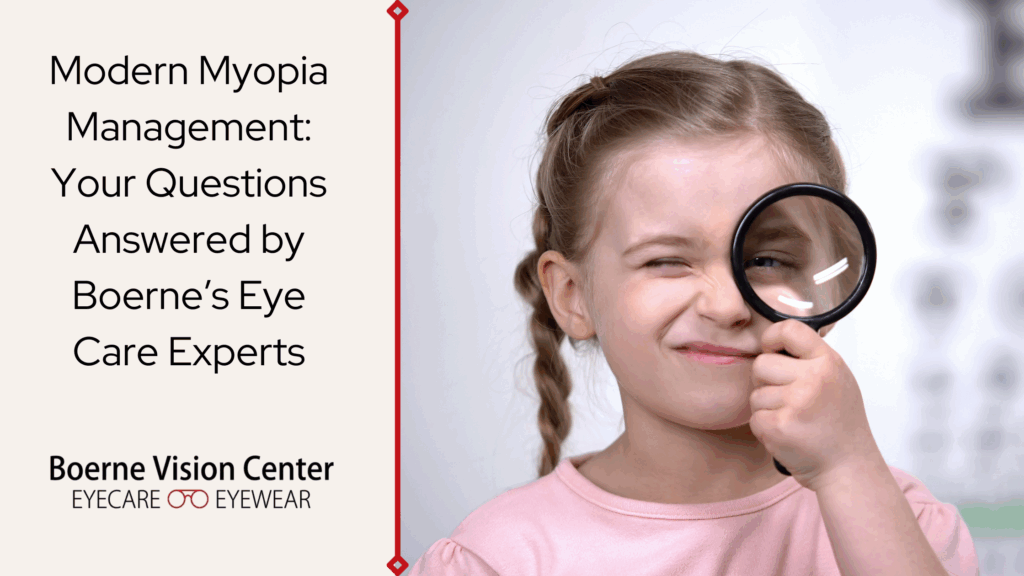Introduction
The world faces a startling reality – myopia will affect nearly half of our global population by 2050. Research shows that 49.8% of people worldwide (about 4.758 billion people) will develop myopia, and 938 million will suffer from high myopia.
The numbers paint a concerning picture. Only 20% of eyecare practitioners currently offer myopia control methods. The good news? Modern treatments can reduce myopia progression by up to 78%. Several treatment options can slow down nearsightedness in children and teenagers. These include specialized spectacle lenses, soft contact lenses, orthokeratology (Ortho-K), and atropine eye drops.
Making the right choice about your child’s myopia control treatment might seem daunting. Our Boerne practice has created this complete guide to help. We’ll answer your questions about pediatric myopia – a condition that affects about 23% of people worldwide. This information will help you make better decisions about your child’s vision future.
Understanding Myopia and Why It’s Rising
Myopia makes distant objects appear blurry while keeping close objects clear. People with this condition, also called nearsightedness, have eyes that focus images in front of their retina instead of directly on it. Your eyeball might grow too long or your cornea’s curve might become too steep. These changes cause light rays to focus incorrectly.
What is myopia and how it develops
Most children develop myopia between ages 6-14. Their eyeballs can grow too quickly during these important years. This rapid growth leads to progressive myopia.
Several factors can cause myopia:
- Genetics – A child’s risk becomes 3 times higher with one myopic parent and 6 times higher with two myopic parents
- Limited outdoor activity – Children who spend less than 40 minutes outside each day face substantially higher myopia rates
- Too much close-up work – Reading, using digital devices, and other close-range activities put stress on young eyes
- Environmental factors – Living in cities, higher education levels, and increased screen time relate to higher myopia rates
Why early intervention matters
Early treatment can prevent serious complications. Each increase in prescription strength (measured in diopters) raises the risk of eye problems later in life. To cite an instance, mild myopia (-1.00D to -3.00D) doubles the chance of retinal detachment. High myopia (-6.00D or worse) makes this risk 14 times greater.
Children respond better to treatment because their eyes continue to develop. Starting myopia management early can slow its progression by 30-80%. This reduction helps prevent high myopia and its complications in adulthood.
The global rise in childhood myopia
Myopia rates have exploded worldwide over the last several years. East Asian countries face epidemic levels, with 80-90% of young adults affected in South Korea and Taiwan.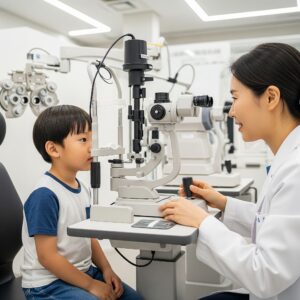 North American and European rates have doubled since the 1970s.
North American and European rates have doubled since the 1970s.
This dramatic increase points to environmental causes since genetic changes don’t happen faster. Modern lifestyle choices create perfect conditions for myopia. More indoor time, digital device use, and academic pressure all contribute to this trend.
Today’s children develop myopia at younger ages than ever before. This early onset gives the condition more time to worsen before eye growth naturally stops in early adulthood.
Exploring the Main Myopia Treatment Options
Modern myopia management gives us better options than just regular glasses. Let’s look at how new treatments can slow down vision changes by a lot in children and teens.
Spectacle lenses: from single vision to lenslets
Regular glasses fix blurry vision but don’t deal very well with myopia getting worse. 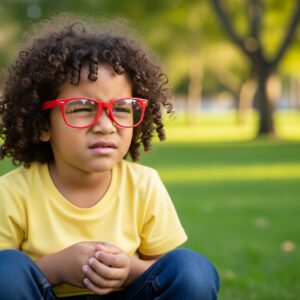 New lenses with aspherical lenslets have better results. The Highly Aspherical Lenslet (HAL) technology cut myopia progression by 55% and eye lengthening by 51% when compared to regular lenses over two years. Kids who wore these lenses at least 12 hours each day had even better outcomes—their myopia slowed down by 67%.
New lenses with aspherical lenslets have better results. The Highly Aspherical Lenslet (HAL) technology cut myopia progression by 55% and eye lengthening by 51% when compared to regular lenses over two years. Kids who wore these lenses at least 12 hours each day had even better outcomes—their myopia slowed down by 67%.
Soft contact lenses: daily disposables and multifocals
Multifocal soft contact lenses are a great way to get control over myopia. These lenses fix central vision and create peripheral myopic defocus that tells the eye to slow its growth. The MiSight 1 day lens—which the FDA approved for kids aged 8-12—reduced myopia progression by 59% and eye growth by 52% compared to standard lenses over three years. The BLINK study also showed high-add multifocal lenses slowed myopia changes by 43% over three years.
Ortho-K: reshaping vision overnight
Orthokeratology (Ortho-K) uses special rigid lenses that work while you sleep. These lenses reshape the cornea overnight so you can see clearly during the day without glasses.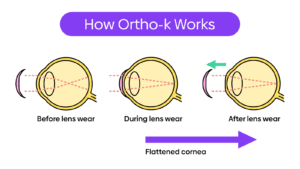 Studies show Ortho-K cuts eye lengthening by about 45-50%. This happens because the lenses change how peripheral light focuses in front of the retina, which signals the eye to stop growing.
Studies show Ortho-K cuts eye lengthening by about 45-50%. This happens because the lenses change how peripheral light focuses in front of the retina, which signals the eye to stop growing.
Atropine eye drops: what the research says
Low-dose atropine eye drops have shown they work to slow myopia progression. Scientists aren’t sure exactly how they work, but studies reveal the effects depend on concentration. The LAMP study found atropine 0.05% reduced vision changes by 67% and eye growth by 51% compared to placebo after one year.
How Effective Are These Myopia Control Methods?
Parents who need to think over myopia management options should understand how different treatments compare. This knowledge helps them make better decisions about their child’s eye care. Recent research gives us clear evidence about which treatments work best and when to use them.
Comparing treatment outcomes
Studies show big differences in how well various myopia control methods work. Highly Aspherical Lenslet (HAL) spectacle lenses showed impressive results. These lenses slowed myopia progression by 57% and axial elongation by 52% over six years. MiSight contact lenses work just as well. They reduce myopia progression by 59% and axial elongation by 52% compared to regular lenses. Atropine eye drops at 0.05% concentration work even better. They slow progression by 67% and axial elongation by 51%.
Age-specific effectiveness
The right timing affects how well these treatments work. Young children get better results because myopia moves faster in developing eyes. Most studies look at children aged 6-16, but each treatment has its own age range. Doctors can use atropine from age 4, ortho-K from age 6, soft contact lenses from age 7-8, and specialized spectacles from age 8. Myopia usually stabilizes at different ages. About half of myopic children reach stability by age 16, 77% by age 18, and 90% by age 21.
Side effects and safety considerations
These treatments are safe when prescribed correctly. Low-dose atropine might cause temporary light sensitivity and near vision issues, but lower concentrations reduce these effects by a lot.
Duration of treatment and long-term results
Your Boerne Vision Doctor will suggest continuing myopia management until eye growth naturally stops. DIMS spectacle lenses managed to keep working well over six years without losing effectiveness. MiSight contact lenses also showed lasting benefits with no bounce-back effect after stopping. Eye care experts recommend treatment through the late teenage years. Research shows ortho-K should continue past age 14.
MiSight contact lenses also showed lasting benefits with no bounce-back effect after stopping. Eye care experts recommend treatment through the late teenage years. Research shows ortho-K should continue past age 14.
Choosing the Right Myopia Management Plan
Your child’s unique needs will help determine the best myopia management approach. A survey by the American Optometric Association shows that 87% of doctors talk about myopia management with parents when their child is between 5 and 8 years old.
Factors to consider: age, lifestyle, and eye health
Research shows myopia management treatments work best in children from around age 6 through 16. 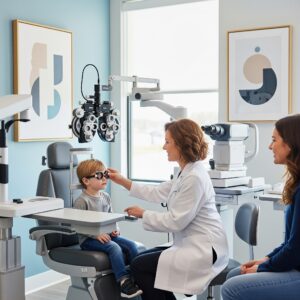 Children under 6 need special attention since early-onset myopia can signal other health conditions.
Children under 6 need special attention since early-onset myopia can signal other health conditions.
Your child’s daily routine shapes treatment options. Sports and physical activities might make ortho-K or scleral lenses less practical. Specially designed spectacles or daytime contact lenses could work better. Screen time and reading habits matter too. Kids who do lots of close-up work might do better with multifocal glasses or contact lenses.
A full eye exam will give a clear picture of your child’s visual acuity, eye health, myopia progression, and risk factors. Some treatments might not suit children with significant binocular vision issues. Multifocal and orthokeratology lenses can make children more exophoric.
When to combine treatments
Treatment combinations often work better than single approaches. Recent studies show that dual therapy can slow myopic progression more effectively. The combination of orthokeratology with 0.01% atropine has substantially slowed axial length elongation compared to either treatment alone, especially in the first six months.
Working with your eye care provider
Your optometrist will help you navigate treatment options based on a complete evaluation of your child’s eyes.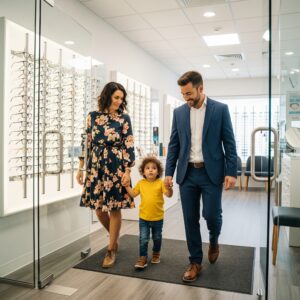 Regular check-ups help track progress and adjust treatment as needed. Your child’s outdoor time and screen habits should be part of the discussion to create a full management plan. Two hours of daily outdoor activity can help delay myopia onset.
Regular check-ups help track progress and adjust treatment as needed. Your child’s outdoor time and screen habits should be part of the discussion to create a full management plan. Two hours of daily outdoor activity can help delay myopia onset.
The best results come from teamwork between parents, child, and eye care professional. This shared approach helps everyone stick to the chosen treatment plan. Practical details matter too, like making sure contact lens supplies are available when children split time between different homes.
Conclusion
Myopia management has evolved substantially beyond traditional glasses and now offers real hope to protect your child’s vision. The most compelling evidence shows early intervention can reduce myopia progression by 30-80%, based on the treatment method you choose. Myopia rates keep climbing worldwide, but you now have access to proven options that slow this condition effectively.
Specialized spectacle lenses, soft contact lenses, orthokeratology, and atropine eye drops show remarkable results with early implementation. Your child’s age, lifestyle, and overall eye health will definitely influence the best approach. On top of that, combining treatments often leads to better outcomes, especially when you have orthokeratology paired with low-dose atropine.
The timing of myopia management plays a crucial role. These interventions benefit children most during their critical growth years, especially when they are between ages 6-16. Your eye care provider can track progress through regular monitoring and adjust the treatment as needed.
Today’s action protects your child’s vision for decades ahead. Each prevented diopter of myopia progression substantially reduces their lifetime risk of serious eye conditions like retinal detachment and myopic maculopathy. The global myopia epidemic shouldn’t mean your child faces the same high risks linked to progressive nearsightedness.
A successful myopia management plan needs a strong partnership between parents, children, and eye care professionals.  Your Boerne eye care team can help develop a customized plan that matches your child’s unique needs and lifestyle. This shared approach will give the best possible visual outcomes, letting your child enjoy clear, healthy vision throughout their life.
Your Boerne eye care team can help develop a customized plan that matches your child’s unique needs and lifestyle. This shared approach will give the best possible visual outcomes, letting your child enjoy clear, healthy vision throughout their life.


